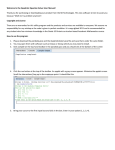Download Quadratic Functions
Transcript
6/19/2015 Analytical Geometry Analytical Geometry Quadratic Functions Quadratic Functions What does the accelerator in a car, a kitchen sink, an airplane, the spots on a giraffe, a cell phone and insect population have in common? They all use quadratic functions! Quadratics are used in the creation and understanding of an infinite number of things in the world. The spots on a cheetah can actually be predicted and outlined before it is even born through the use of quadratic equations. We would not have cell phones as efficient as they are today if it weren't for mathematicians using quadratics in mathematical calculations to test early prototypes. In this module, you will learn how to interpret polynomial functions both algebraically and graphically. Essential Questions What are the parts of a polynomial? How can we use quadratic equations and inequalities to solve problems? How can we use a system of equations to solve problems? What are the features of a graph of a quadratic? How can a quadratic equation be solved algebraically? What happens to a quadratic equation when the graph is transformed? How do quadratic functions compare to linear and exponential functions? How can we use quadratic regression to find equations that fit real world problems? Module Minute Quadratic functions can be solved algebraically by taking the square root, factoring, completing the square, or using the quadratic formula. Sometimes the solution will result in a complex number. Quadratics can also be solved graphically. When looking at a graph of a quadratic, we can identify the extrema values, intercepts, intervals of increase and decrease, symmetries and end behavior. When applied to real world problems, this presents a wealth of information. Many real world situations are better modeled by a parabola rather than a linear or exponential equation. The structure of a quadratic equation can tell us whether the graph will open up or down as well as provide us with information about how the graph may have transformed from its parent function. Key Words Horizontal shift A rigid transformation of a graph in a horizontal direction. Vertex form of a quadratic function A quadratic equation written in the form f(x) = a(x h)2 + k, where a is a nonzero constant and (h, k) is the vertex of the graph. Discriminant The number b2 4ac when a quadratic equation is written in the form y = ax2 + bx + c. Quadratic Formula The solutions of the quadratic equation in the form y = ax2 + bx + c, when a is nonzero and b and c are real numbers, http://cms.gavirtualschool.org/Shared/Math/CCGPS_AnalyticalGeometry/05_QuadraticFunctions/05_AnalyticalGeometry_QuadraticFunctions_SHARED_prin… 1/34 6/19/2015 Analytical Geometry A handout of these key words and definitions is also available in the sidebar. What To Expect Quadratic Functions Discussion Factoring Quiz Paula's Peaches Task Parent Graphs Task Solving Quadratics Quiz Acme Factory Project Quadratic Functions Test To view the standards from this unit, please download the handout from the sidebar. Solving Polynomial Equations In the previous lesson we learned how to simplify polynomial expressions. We will now learn how to find the solutions of the expressions. Before we start solving, we need to review a very important property, the Zero Product Property. We will soon look at graphing new functions. When we graph we will refer to the graph's roots or zeros. The zeros of a function are any values for x when y equals zero. Using those two pieces of information we can solve the following examples: Example 1: Solve (x 1)(x + 3) = 0 http://cms.gavirtualschool.org/Shared/Math/CCGPS_AnalyticalGeometry/05_QuadraticFunctions/05_AnalyticalGeometry_QuadraticFunctions_SHARED_prin… 2/34 6/19/2015 Analytical Geometry Notice that this problem is made up of two binary expressions that are multiplied together to equal zero. This means that at least one of those binary expressions must be zero. We will set each expression equal to zero in order to find what solutions cause this statement to be true. The two solutions, or zeros, are x = 1 and x = 3. Example 2: Example 3: http://cms.gavirtualschool.org/Shared/Math/CCGPS_AnalyticalGeometry/05_QuadraticFunctions/05_AnalyticalGeometry_QuadraticFunctions_SHARED_prin… 3/34 6/19/2015 Analytical Geometry Each of the above examples was written in factored form. This means that the expressions were written as terms that were multiplied together. Sometimes we will have problems that are not in factored form which means that we need to factor them first. Recall that the greatest common factor (GCF) is the largest common divisor of each term of a polynomial. Finding Greatest Common Factor Steps 1. Find the largest factor of each coefficient. 2. For variables, the variable must be present in each term. Choose the variable with the smallest exponent. Finding GCF examples: Example 1: 4x3y7, 2xy9, 12x5 2x is the GCF since 2 is the largest number that can be factored out of 4, 2, and 12 and each of the monomials has at least one x. Example 2: m3n5, 4m6n, 8m4n11 m3n is the GCF! Monomial Factoring http://cms.gavirtualschool.org/Shared/Math/CCGPS_AnalyticalGeometry/05_QuadraticFunctions/05_AnalyticalGeometry_QuadraticFunctions_SHARED_prin… 4/34 6/19/2015 Analytical Geometry Recall that the distributive property allows us to multiply x by each term in the above binomial. The opposite of the distributive property is factoring. We can use monomial factoring to do the reverse of the above problem. Notice that the two terms have x in common, so we can factor the x out and write what is left inside parenthesis. Monomial factoring is the opposite of distribution! Steps to Monomial Factoring Steps to Solve by Factoring 1. Find the GCF of the polynomial 2. Divide the GCF into the original polynomial 3. Rewrite as a product of the GCF and the new, divided polynomial 1. Set the equation equal to zero 2. Factor completely 3. Find the zeros for each factor Factoring Trinomials with a Leading Coefficient of 1 A standard trinomial will be in the form ax2 + bx + c where a, b, and c are integers. In the past, we have used multiplication and the distributive property to get these trinomials. Now, let's determine how to factor them. We will begin by factoring trinomials that have a leading coefficient of 1. This means the a value in our standard form will be 1. Recall the FOIL method that we used when multiplying two binomials. (x +1)(x 2) = x2 2x + x 2 = x2 x 2 Let's factor the trinomial: x2 x 2 = We know that this trinomial will result in the product of two binomials (based on the previous FOIL example.) We also know that the factors of x2 are x and x. We then need to think of two numbers that have a product to equal our last term, 2, but a sum to equal our middle term, 1. If we list the factors of a our last term 2, we get: http://cms.gavirtualschool.org/Shared/Math/CCGPS_AnalyticalGeometry/05_QuadraticFunctions/05_AnalyticalGeometry_QuadraticFunctions_SHARED_prin… 5/34 6/19/2015 Analytical Geometry 1 , 2 1, 2 These are the only two factors that have a product of 2. Which of these pairs has a sum of 1? ANSWER Using these two numbers, write our trinomial as the product of two binomials: (x +1)(x 2) Factoring trinomials is essentially the opposite of the FOIL method. Steps for Factoring Trinomials with a Leading Coefficient of 1 For the polynomial ax2 + bx + c 1. Determine all the factors of c. 2. Determine which factors of c equal b when added or subtracted 3. Rewrite your trinomial as the product of two binomials Example 1: Factor x2 + 5x + 6 Factors of 6: 1, 6 1, 6 2, 3 2, 3 Which of these factors add up to 5? ANSWER So our final answer would be: (x + 2)(x + 3) Example 2: Factor x2 + 11x + 24 Final Answer: (x + 3)(x + 8) Example 3: Factor x2 7x 18 Final Answer: (x 9)(x + 2) Example 4: Factor x2 9x 36 Final Answer: (x 12)(x + 3) http://cms.gavirtualschool.org/Shared/Math/CCGPS_AnalyticalGeometry/05_QuadraticFunctions/05_AnalyticalGeometry_QuadraticFunctions_SHARED_prin… 6/34 6/19/2015 Analytical Geometry Example 5: Factor x2 10x + 24 Final Answer: (x 6)(x 4) Factoring Trinomials with a Leading Coefficient not Equal to 1 What do we do when we have to factor a trinomial, ax2 + bx + c, where a does not equal 1? This will change our steps since we will need to consider the leading coefficient. Depending on what the leading coefficient is, there may be different steps to take. Once we factor the trinomial's we can use the zero product property to solve. Remember that if the two binomials multiplied together equal zero, than one or both of them must also equal zero. Quadratic Functions Discussion It is now time to complete the "Quadratic Functions" discussion Post one polynomial that should be factored by grouping. After you have posted your problem, factor another classmate's problem. Once a classmate has factored the problem you created, reply, letting them know if the answer is correct or not. You will have a total of 3 posts when you are done with this discussion. Factor Polynomials Completely Polynomials sometimes require multiple steps to factor completely. For example, you might have to factor out a GCF from a trinomial and then continue to factor the trinomial into two binomials. Check out the following video: Example 1: Factor completely, 4x3 x This example can be factored both by dividing by a GCF (x) and then by factoring the resulting binomial. x(4x2 1) Notice that there are only two terms, however, since x is squared we can still factor. We can pretend that there is a middle term and it happens to be zero. x(4x2 + 0x 1) Now think of factors for 1 that add up to 0. x(2x +1)(2x 1) http://cms.gavirtualschool.org/Shared/Math/CCGPS_AnalyticalGeometry/05_QuadraticFunctions/05_AnalyticalGeometry_QuadraticFunctions_SHARED_prin… 7/34 6/19/2015 Analytical Geometry There are three factors for this polynomial! Factor by Grouping Occasionally, polynomials will be written in a way that looks as if someone started to factor but did not finish. Example 2: Factor by Grouping, x(3x 1) 2(3x 1) This problem looks as if someone started to factor using the six step method but then stopped at step 5. All we need to do is finish that last step. We can write this polynomial as two binomials because the parenthesis contain the same expression. (x 2)(3x 1) Example 3: Factor by grouping. 3x(4 + y) 6(4 + y) (3x 6)(4 + y) Example 4: Factor by grouping. x2 3x 4x + 12 Notice that this example does not have the parenthesis in place. This is as if we are at step 3 of the 6step process. Remember, when adding parenthesis, always have a '+' sign between them. (x2 3x) + (4x + 12) Now we can factor out the GCF from each binomial and continue the factoring process. x(x 3) + 4(x 3) (x 4)(x 3) Example 5: Factor by grouping: 3n3 3n2 + n 1 (3n3 3n2)+ (n 1) 3n2(n 1) + (n 1) (3n2 + 1)(n 1) Here are the steps for Factoring Completely for your review: http://cms.gavirtualschool.org/Shared/Math/CCGPS_AnalyticalGeometry/05_QuadraticFunctions/05_AnalyticalGeometry_QuadraticFunctions_SHARED_prin… 8/34 6/19/2015 Analytical Geometry Graphing Quadratics Graph y = ax2 + c Since we know how to factor and solve polynomials, let's look at graphing. We are going to learn to graph quadratic functions. A quadratic function is a polynomial with degree 2. You have already learned to solve quadratics by factoring in the above lessons. The standard form of a quadratic function is written as follows: y = ax2 + bx + c When quadratics are graphed they form a ushaped graph. The ushaped graph of a quadratic function is called a parabola. http://cms.gavirtualschool.org/Shared/Math/CCGPS_AnalyticalGeometry/05_QuadraticFunctions/05_AnalyticalGeometry_QuadraticFunctions_SHARED_prin… 9/34 6/19/2015 Analytical Geometry The maximum and minimum point on a parabola is called the vertex. http://cms.gavirtualschool.org/Shared/Math/CCGPS_AnalyticalGeometry/05_QuadraticFunctions/05_AnalyticalGeometry_QuadraticFunctions_SHARED_pri… 10/34 6/19/2015 Analytical Geometry The vertical line that passes through the vertex of a parabola, dividing the parabola into symmetric parts, is called the axis of symmetry. To graph a quadratic function, we can use a table of values and plot the points. The Parent Quadratic Function http://cms.gavirtualschool.org/Shared/Math/CCGPS_AnalyticalGeometry/05_QuadraticFunctions/05_AnalyticalGeometry_QuadraticFunctions_SHARED_pri… 11/34 6/19/2015 Analytical Geometry The parent quadratic function is: y = x2 Notice the domain is all real numbers and the range is y ≥ 0. Transformations of the Parent Function (Review the transformations that you learned from your previous course.) http://cms.gavirtualschool.org/Shared/Math/CCGPS_AnalyticalGeometry/05_QuadraticFunctions/05_AnalyticalGeometry_QuadraticFunctions_SHARED_pri… 12/34 6/19/2015 Analytical Geometry The following quadratics are graphed below. Pay close attention to each equation and how they compare to the graph of the parent function. Domain and Range Graph the function y = 3x2 + 4 and identify its domain and range. Compare it to the parent function y = x2. We can see both from the equation and the graph that there are three transformations that have taken place. The first transformation is the negative sign in front of the equation. This tells us that the function has been reflected across the xaxis. Next, the number 3 tells us that the function has been vertically stretched by a factor of 3. Finally, the 4 that is added to the end of the equation tells us that the function has been translated up 4 units. The domain is still all real numbers, however the range has become y ≤ 4. Graph the function y = ½x2 2 and identify its domain and range. Compare it to the parent function y = x2. The domain is all real numbers. The range is y ≥ 2. The graph has a vertical shrink by a factor of 2 and has been translated down 2 units from the parent function. http://cms.gavirtualschool.org/Shared/Math/CCGPS_AnalyticalGeometry/05_QuadraticFunctions/05_AnalyticalGeometry_QuadraticFunctions_SHARED_pri… 13/34 6/19/2015 Analytical Geometry Graph the function y = 5x2 + 2 and identify its domain and range. Compare it to the parent function y = x2. The domain is all real numbers. The range is y ≤ 2. The graph has been reflected across the xaxis, vertically stretched by a factor of 5 and translated up 2 units from the parent function. Factoring Quiz It is now time to complete the "Factoring Quiz" quiz. You will have a limited amount of time; please plan accordingly. Graph y = ax2 + bx + c In the previous lesson we learned to graph quadratics that did not have the b term. Now we will discover how to graph a quadratic function when the b term is present. Graphs such as these will not have the vertex on the yaxis as we have previously seen. Remember that the vertex is the MAXIMUM or MINIMUM point of a parabola. For the equation y = ax2 + bx + c: http://cms.gavirtualschool.org/Shared/Math/CCGPS_AnalyticalGeometry/05_QuadraticFunctions/05_AnalyticalGeometry_QuadraticFunctions_SHARED_pri… 14/34 6/19/2015 Analytical Geometry Find the Vertex: The vertex is a point (ordered pair). Using y = ax2 + bx + c , we can find the x value of the vertex with the formula, To find y, plug your value for x into the original equation and solve. Recall Axis of Symmetry The axis of symmetry is always equal to the xvalue of the vertex. http://cms.gavirtualschool.org/Shared/Math/CCGPS_AnalyticalGeometry/05_QuadraticFunctions/05_AnalyticalGeometry_QuadraticFunctions_SHARED_pri… 15/34 6/19/2015 Analytical Geometry Solving Quadratic Equations by Graphing We have already learned how to solve quadratic equations by factoring. It is also possible to solve by graphing Remember that we called the solutions to quadratics the roots or zeros of the problem. That is because the solutions are the xintercepts, or where the graph crosses the xaxis. If you are given a graph of a quadratic function, you do not need to factor to find the solutions if you are able to read the xintercepts from the graph. Example 3: Find the solutions for the following graph: Since the graph crosses the xaxis at 2 and 5, the solutions are x = 2 and x = 5. Example 4: Find the solutions for the following graph: http://cms.gavirtualschool.org/Shared/Math/CCGPS_AnalyticalGeometry/05_QuadraticFunctions/05_AnalyticalGeometry_QuadraticFunctions_SHARED_pri… 16/34 6/19/2015 Analytical Geometry This graph does not have any xintercepts, therefore, there are no solutions. Rule for checking solutions: To determine if a value is a solution, plug it into the original equation and see if both sides are equal. Example 4: Is x = 3 a solution for the equation 0 = 2x2 5x + 1? 0 = 2(3)2 5(3) + 1 0 = 2(9) 5(3) + 1 0 = 18 15 + 1 0 = 4 ANSWER Example 5: Is x = 3 a solution for the equation 0 = x2 6x + 9? 0 = 32 6(3) + 9 0 = 9 6(3) + 9 0 = 9 18 + 9 0 = 0 ANSWER Solving Quadratics using a Graphing Calculator Solving quadratics by graphing is not always the most efficient method to solve because, oftentimes, graphs are difficult to read. This is especially true if the solutions are not whole numbers. To make it easier, you can use a graphing calculator. The following are instructions for a TI graphing calculator (83, 84, Plus). If you have another http://cms.gavirtualschool.org/Shared/Math/CCGPS_AnalyticalGeometry/05_QuadraticFunctions/05_AnalyticalGeometry_QuadraticFunctions_SHARED_pri… 17/34 6/19/2015 Analytical Geometry brand of calculator you can search the internet or read the user manual for instructions on how to find the zero of a graph. Using Square Roots to Solve Quadratic Equations Do you remember learning about square roots? Positive numbers have both a positive square root and negative square root. The positive square root is called the principle square root. You cannot take the square root of a negative number. The square root symbol is called a radical. The number under the square root is called the radicand. Using square roots is another method that can be used to solve quadratic equations. Solving Quadratic Equations (Steps) 1. Determine what is being squared in the equation. 2. Get the squared item by itself. 3. Take the square root of both sides (do not forget the square root is both positive and negative). Example: Solve for the variable. http://cms.gavirtualschool.org/Shared/Math/CCGPS_AnalyticalGeometry/05_QuadraticFunctions/05_AnalyticalGeometry_QuadraticFunctions_SHARED_pri… 18/34 6/19/2015 Analytical Geometry x2 9 = 0 x2 = 9 x = ±3 Solving Systems of Equations by Graphing When given two, or more, equations (system of equations) it is possible to solve by graphing using a graphing calculator. The solutions to a system of equations are the point(s) where the graphs intersect. The following are the steps to solving using a TI graphing calculator. Example 1: Solve the following rational equation by graphing. x2 + 1 = x + 3 http://cms.gavirtualschool.org/Shared/Math/CCGPS_AnalyticalGeometry/05_QuadraticFunctions/05_AnalyticalGeometry_QuadraticFunctions_SHARED_pri… 19/34 6/19/2015 Analytical Geometry You should have seen from the video example that the correct answer is x = 2 and x = 1. Example 2: Solve the following rational equation by graphing. x2 + 14 = You should see from the graph above that the correct answer is x = 4. Graphing Quadratics Functions in Vertex Form Quadratic functions are not always written in standard form. They can also be written in vertex form: y = a(x h)2 + k where (h, k) is the vertex. The axis of symmetry for a quadratic in vertex form is x = h. To graph a quadratic function in vertex form we will use the same steps for graphing that we learned previously, however, we will not have to find the vertex since it is given to us in the equation. Example 3: Graph y = (x 2)2 4 Vertex: (2, 4) Domain: All Real Numbers Range: y ≥ 4 Axis of Symmetry: x = 2 x 0 1 2 3 4 y 0 3 4 3 0 http://cms.gavirtualschool.org/Shared/Math/CCGPS_AnalyticalGeometry/05_QuadraticFunctions/05_AnalyticalGeometry_QuadraticFunctions_SHARED_pri… 20/34 6/19/2015 Analytical Geometry Changing Vertex Form to Standard Form Sometimes you will find it necessary to change quadratic equations from vertex form to standard form. This is especially useful if you want to factor the quadratic. To change from vertex form to standard form you will simply apply the order of operations and combine like terms. Example 4: Convert y = 2(x 3)2 + 3 to standard form. y = 2(x 3)(x 3) + 3 y = 2(x2 6x + 9) + 3 y = 2x2 12x + 18 + 3 y = 2x2 12x + 21 Example 5: Convert y = 3(x + 4)2 1 to standard form. y = 3x2 24x 49 Graphing Quadratic Functions in Intercept Form Intercept form is y = a(x p)(x q) where p and q are the intercepts. The steps to graphing are the same after we find the vertex. (Notice that intercept form is the same as factored form.) The axis of symmetry for a quadratic in intercept form is . To find the vertex in intercept form: Graph y = (x2)(x + 2). Intercepts: x = 2 and x = 2 Vertex: (0, 4) Domain: All real numbers Range: y ≥ 4 Axis of Symmetry: x = 0 x 2 1 0 1 2 y 0 3 4 3 0 http://cms.gavirtualschool.org/Shared/Math/CCGPS_AnalyticalGeometry/05_QuadraticFunctions/05_AnalyticalGeometry_QuadraticFunctions_SHARED_pri… 21/34 6/19/2015 Analytical Geometry Changing Intercept Form to Standard Form To change from intercept form to standard form, simply foil, distribute, and combine like terms. Change y = (x + 3)(x 2) to standard form. y = (x2 + x 6) y = x2 x + 6 Change y = 2(x + 5)(x 2) to standard form. y = 2x2 + 6x 20 Graphing Quadratic Inequalities Graphing inequalities is just like graphing any other equation. There are two differences. First, you have to check to see if your graph will be solid or dashed. Second you have to decide where to shade. Graph y ≥ x2 + 4x 1 Remember, ≥ and ≤ represent solid lines. < and > represent dashed lines. A dashed line means the solution to the function is not on the line. Since our example has is ≥ we will graph it as normal with a solid line. http://cms.gavirtualschool.org/Shared/Math/CCGPS_AnalyticalGeometry/05_QuadraticFunctions/05_AnalyticalGeometry_QuadraticFunctions_SHARED_pri… 22/34 6/19/2015 Analytical Geometry This is the graph of the equation. Now to graph the > part we need to shade all of the possible solutions. To figure out which side of the graph to shade, simply select a point that is not on the graph and test it in your equation. If the point is true, then shade that side. If it is false, shade the other side. Let's test the point (1, 1) 1 ≥ (1)2 + 4(1) 1 1 ≥ 1 + 4(1) 1 1 ≥ 1 4 1 1 ≥ 4 True shade the region that contains this point. Match the following inequalities with their graphs. http://cms.gavirtualschool.org/Shared/Math/CCGPS_AnalyticalGeometry/05_QuadraticFunctions/05_AnalyticalGeometry_QuadraticFunctions_SHARED_pri… 23/34 6/19/2015 Analytical Geometry Solving Systems of Inequalities Recall that a system of inequalities is simply two or more inequalities graphed on the same coordinate plane. The solutions to the system will be contained in the overlapping shaded region (the region shaded by both inequalities). Graph the system: y > x2 2x 1 y < x2 + 3x + 1 Paula's Peaches Task Download the Paula's Peaches Task Assignment from the sidebar and complete your answers on a separate word document. Please save your work and submit your completed assignment. Average Rates of Change for Graphs To find the average rate of change between two points, simply find the slope of the line that connects those two points. Example 1: Find the average rate of change of f(x) = x3 3x from x1 to x2 given that x1 = 2 and x2 = 0. f(2) = (2)3 3(2) f(2) = 8 3(2) f(2) = 8 + 6 f(2) = 2 f(0) = 03 3(0) f(0) = 0 3(0) f(0) = 0 0 f(0) = 0 http://cms.gavirtualschool.org/Shared/Math/CCGPS_AnalyticalGeometry/05_QuadraticFunctions/05_AnalyticalGeometry_QuadraticFunctions_SHARED_pri… 24/34 6/19/2015 Analytical Geometry Example 2: Compare the rates of change for f(x) = 2x and g(x) = f(x) = 2x f(0) = 2(0) f(0) = 0 from x1 = 0 to x2 = 4. g(x) = g(0) = g(0) = 0 f(4) = 2(4) f(4) = 8 g(4) = g(4) = 2 (Only use positive value since there is not a negative sign in from of the ) The two graphs both have positive average rates of change. However, f(x) has a higher average rate of http://cms.gavirtualschool.org/Shared/Math/CCGPS_AnalyticalGeometry/05_QuadraticFunctions/05_AnalyticalGeometry_QuadraticFunctions_SHARED_pri… 25/34 6/19/2015 Analytical Geometry change so it is increasing faster than g(x). Example 3: Calculate the average rate of change of the function y=2x2 1 on the interval 1 ≤ x ≤ 0. Plug in 1: y = 2(1)2 1 y = 2(1) 1 y = 2 1 y = 1 (1, 1) Plug in 0: y = 2(0)2 1 y = 2(0) 1 y = 0 1 y = 1 (0, 1) Find the average rate of change (slope formula) Identifying Intervals of Increase and Decrease Recall the intervals of increase and decrease are intervals where a graph increase or decreases along the xaxis. The intervals are determined by x. Example 4: Graph the y = x2 + 2x 1. Determine the vertex and the intervals of increase and decrease. Vertex: x = x = x = x = 1 y = (1)2 + 2(1) 1 y = 1 +2(1) 1 y = 1 2 1 http://cms.gavirtualschool.org/Shared/Math/CCGPS_AnalyticalGeometry/05_QuadraticFunctions/05_AnalyticalGeometry_QuadraticFunctions_SHARED_pri… 26/34 6/19/2015 Analytical Geometry y = 2 (1, 2) Increasing: x > 1 Decreasing: x < 1 Example 5: Graph the y = (x + 1)(x 3). Determine the vertex and the intervals of increase and decrease. Vertex: x = x = x = 1 y = (1 + 1)(1 3) y = (2)(2) y = 4 (1, 4) Increasing: x < 1 Decreasing: x > 1 Now try this one on your own! http://cms.gavirtualschool.org/Shared/Math/CCGPS_AnalyticalGeometry/05_QuadraticFunctions/05_AnalyticalGeometry_QuadraticFunctions_SHARED_pri… 27/34 6/19/2015 Analytical Geometry Graph the y = 3x2 6x + 4. Determine the vertex and the intervals of increase and decrease. Vertex: ? Increasing: ?? Decreasing: ??? Parent Graphs Assignment Download the Parent Graphs Assignment from the sidebar and complete your answers on a separate word document. Please save your work and submit it. Solving Quadratics by Completing the Square You will notice that some quadratics have perfect squares as the c value. We call these perfect square trinomials. Try multiplying (x + 5)2. (x + 5)(x+ 5) x2 + 10x + 25 This is called a perfect square trinomial because the c value, 25, is a perfect square. Multiply (x 9)2. (x 9)(x 9) x2 18x + 81 This is also a perfect square trinomial because 81 is a perfect square. Which value of c will x2 + 6x + _______ be a perfect square trinomial? Which value of x will x2 12x + ______ be a perfect square trinomial? Now we will learn a new method for solving quadratic equations. We have already learned to solve by factoring and by graphing. This method is called completing the square. http://cms.gavirtualschool.org/Shared/Math/CCGPS_AnalyticalGeometry/05_QuadraticFunctions/05_AnalyticalGeometry_QuadraticFunctions_SHARED_pri… 28/34 6/19/2015 Analytical Geometry The last two options are preferences but not required for completing the square. We will learn another method for solving which is easier than completing the square under those two circumstances. Example 1: Solve 0 = x2 + 8x + 4 by completing the square. Rewrite the problem so that it is equal to c. (Subtract 4 from both sides.) Divide the b term by 2. Square the result from step 2. Add the result from step 3 to both sides of the equal sign. Simplify and factor. Solve for x. http://cms.gavirtualschool.org/Shared/Math/CCGPS_AnalyticalGeometry/05_QuadraticFunctions/05_AnalyticalGeometry_QuadraticFunctions_SHARED_pri… 29/34 6/19/2015 Analytical Geometry (Answers may be written in simplified radical form or with decimals.) Example 2: Solve 0 = x2 14x + 4 4 = x2 14x (7)2 = 49 4 + 49 = x2 14x + 49 45 = (x 7)2 Using the Quadratic Formula and Discriminant We have now learned 3 ways to solve quadratic functions. We can solve by graphing, factoring, or completing the square. Each of these methods is best used for certain types of quadratics. There is one last method that can be used every single time, for any quadratic function! The final method for solving is using the quadratic formula. Quadratic Formula: Learn the Quadratic Formula song to help you remember it! Example 1: Use the quadratic formula to find the solutions of x2 + 7x = 6. First put the quadratic in standard form and identify a, b, and c. x2 + 7x 6 = 0 a = 1 b = 7 c = 6 Plug a, b, and c into the quadratic formula. Simplify and solve! http://cms.gavirtualschool.org/Shared/Math/CCGPS_AnalyticalGeometry/05_QuadraticFunctions/05_AnalyticalGeometry_QuadraticFunctions_SHARED_pri… 30/34 6/19/2015 Analytical Geometry Answers may be kept in simplified radical form or converted to decimal form. x = .772 and x = 7.77 Example 2: Use the quadratic formula to find the solutions for 2x2 8x + 8 = 0. Example 3: Solve using the quadratic formula: x2 + 2x = 5 a = 1 b = 2 c = 5 http://cms.gavirtualschool.org/Shared/Math/CCGPS_AnalyticalGeometry/05_QuadraticFunctions/05_AnalyticalGeometry_QuadraticFunctions_SHARED_pri… 31/34 6/19/2015 Analytical Geometry x = 1 2i This function does not have any real solutions. On the graph for this quadratic, there would be no xintercepts. The discriminant is the number underneath the radical of the quadratic formula, b2 4ac. We can use the discriminant to determine how many, and what types of solutions a quadratic function will have. When the discriminant is: The equation has: negative 2 imaginary solutions zero 1 real solution positive 2 real solutions Example 4: Find the discriminant and tell the number and type of solutions for x2 + 6x + 5 = 0. b2 4ac a = 1 b = 6 c = 5 62 4(1) (5) 36 4(1)(5) 36 20 16 The quadratic will have two real solutions. (This means the graph crosses the xaxis twice.) Example 5: Find the discriminant and tell the number and type of solutions for x2 + 6x + 9 = 0. a = 1 http://cms.gavirtualschool.org/Shared/Math/CCGPS_AnalyticalGeometry/05_QuadraticFunctions/05_AnalyticalGeometry_QuadraticFunctions_SHARED_pri… 32/34 6/19/2015 Analytical Geometry b = 6 c = 9 62 4(1)(9) 36 4(1)(9) 36 36 0 The quadratic has one real solution. (This means the parabola's vertex is on the xaxis resulting in one xintercept.) Solving Quadratics Quiz It is now time to complete the "Solving Quadratics Quiz" quiz. You will have a limited amount of time; please plan accordingly. Module Wrap Up Module Checklist Discussion Factoring Quiz Paula's Peaches Task Parent Graphs Task Solving Quadratics Quiz Acme Factory Project Quadratic Functions Test Review Now that you have completed the initial assessments for this module, review the lesson material with the practice activities and extra resources. Then, continue to the next page for your final assessment instructions. Solve the following by factoring: Solve the following by completing the square: Find the discriminant and use it to determine if the solution has one real, two real or two imaginary solution(s). Then solve for x using the quadratic formula. Solve for x using a method of your choice. Standardized Test Preparation The following problems will allow you to apply what you have learned in this module to how you may see questions asked on a standardized test. Please follow the directions closely. Remember that you may have to use prior knowledge from previous units in order to answer the question correctly. If you have any questions or concerns, please contact your instructor. http://cms.gavirtualschool.org/Shared/Math/CCGPS_AnalyticalGeometry/05_QuadraticFunctions/05_AnalyticalGeometry_QuadraticFunctions_SHARED_pri… 33/34 6/19/2015 Analytical Geometry Final Assessments Quadratic Functions Test It is now time to complete the "Quadratic Functions" Test. Once you have completed all selfassessments, assignments, and the review items and feel confident in your understanding of this material, you may begin. You will have a limited amount of time to complete your test and once you begin, you will not be allowed to restart your test. Please plan accordingly. Acme Factory Project Download the Acme Factory Project from the sidebar and complete your answers on a separate word document. Please save your work and submit it. http://cms.gavirtualschool.org/Shared/Math/CCGPS_AnalyticalGeometry/05_QuadraticFunctions/05_AnalyticalGeometry_QuadraticFunctions_SHARED_pri… 34/34

















































